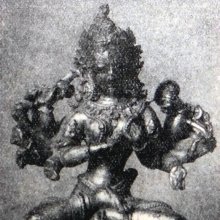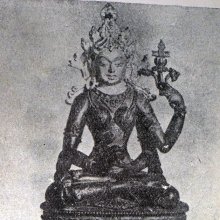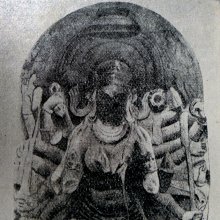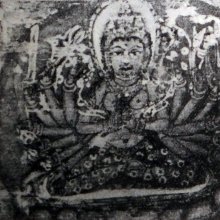Sarvakarmavaranavishodhani, Sarvakarmāvaraṇaviśodhanī, Sarvakarmavarana-vishodhani: 1 definition
Introduction:
Sarvakarmavaranavishodhani means something in Buddhism, Pali. If you want to know the exact meaning, history, etymology or English translation of this term then check out the descriptions on this page. Add your comment or reference to a book if you want to contribute to this summary article.
The Sanskrit term Sarvakarmāvaraṇaviśodhanī can be transliterated into English as Sarvakarmavaranavisodhani or Sarvakarmavaranavishodhani, using the IAST transliteration scheme (?).
Images (photo gallery)
In Buddhism
Tibetan Buddhism (Vajrayana or tantric Buddhism)
Source: archive.org: The Indian Buddhist IconographySarvakarmāvaraṇaviśodhanī (सर्वकर्मावरणविशोधनी) refers to one of the twelve Dhāriṇīs according to the 11th-century Niṣpannayogāvalī of Mahāpaṇḍita Abhayākara.—Dhāriṇī is a peculiar kind of Buddhist literature which is supposed to generate great mystic power if repeated continually for a long time. They are short works mostly composed of meaningless syllables, sometimes revealing traces of a language now defunct. [...] The deification of books is not unknown in Buddhism. [...] The Niṣpannayogavālī acknowledges altogether twelve Dhāriṇī (viz., Sarvakarmāvaraṇaviśodhanī) deities and gives their descriptions. These Dhāriṇīs look alike when represented and they are usually two-armed, holding the Viśvavajra in the right hand and their special symbols in the left.
Sarvakarmāvaraṇaviśodhanī is described in the Niṣpannayogāvalī (dharmadhātuvāgīśvara-maṇḍala) as follows:—
“Sarvakarmāvaraṇaviśodhanī is green in colour and holds in her left hand the vajra with three thongs on a lotus”.
[Her Colour is green; her Symbol is the vajra; she has two arms.—When conceived in the form of deities, the Dhāriṇīs (viz., Sarvakarmāvaraṇaviśodhanī) are endowed with one face and two arms. They all hold in their right hand the double thunderbolt or the viśvavajra, while in the left they carry their own special symbols.]

Tibetan Buddhism includes schools such as Nyingma, Kadampa, Kagyu and Gelug. Their primary canon of literature is divided in two broad categories: The Kangyur, which consists of Buddha’s words, and the Tengyur, which includes commentaries from various sources. Esotericism and tantra techniques (vajrayāna) are collected indepently.
See also (Relevant definitions)
Partial matches: Vishodhani.
Full-text: Dharini.
Relevant text
Search found 1 books and stories containing Sarvakarmavaranavishodhani, Sarvakarmāvaraṇaviśodhanī, Sarvakarmavarana-vishodhani, Sarvakarmāvaraṇa-viśodhanī, Sarvakarmavarana-visodhani, Sarvakarmavaranavisodhani; (plurals include: Sarvakarmavaranavishodhanis, Sarvakarmāvaraṇaviśodhanīs, vishodhanis, viśodhanīs, visodhanis, Sarvakarmavaranavisodhanis). You can also click to the full overview containing English textual excerpts. Below are direct links for the most relevant articles:
The Indian Buddhist Iconography (by Benoytosh Bhattachacharyya)




